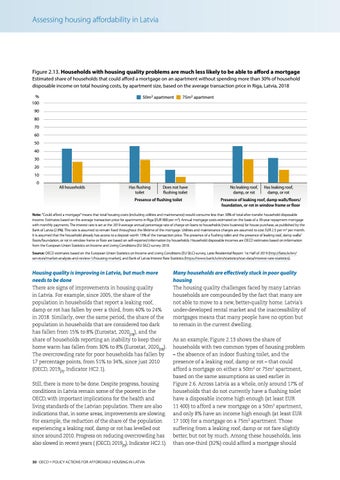Assessing housing affordability in Latvia
Figure 2.13. Households with housing quality problems are much less likely to be able to afford a mortgage Estimated share of households that could afford a mortgage on an apartment without spending more than 30% of household disposable income on total housing costs, by apartment size, based on the average transaction price in Riga, Latvia, 2018 % 100
50m2 apartment
75m2 apartment
90 80 70 60 50 40 30 20 10 0
All households
Has flushing toilet
Does not have flushing toilet
Presence of flushing toilet
No leaking roof, damp, or rot
Has leaking roof, damp, or rot
Presence of leaking roof, damp walls/floors/ foundation, or rot in window frame or floor
Note: “Could afford a mortgage” means that total housing costs (including utilities and maintenance) would consume less than 30% of total after-transfer household disposable income. Estimates based on the average transaction price for apartments in Riga (EUR 900 per m2). Annual mortgage costs estimated on the basis of a 30-year repayment mortgage with monthly payments. The interest rate is set at the 2019 average annual percentage rate of charge on loans to households (new business) for house purchase, as published by the Bank of Latvia (2.9%). This rate is assumed to remain fixed throughout the lifetime of the mortgage. Utilities and maintenance charges are assumed to cost EUR 2.5 per m2 per month. It is assumed that the household already has access to a deposit worth 15% of the transaction price. The presence of a flushing toilet and the presence of leaking roof, damp walls/ floors/foundation, or rot in window frame or floor are based on self-reported information by households. Household disposable incomes are OECD estimates based on information from the European Union Statistics on Income and Living Conditions (EU SILC) survey 2018. Source: OECD estimates based on the European Union Statistics on Income and Living Conditions (EU SILC) survey, Latio Residential Report: 1st Half of 2019 (http://latio.lv/en/ services/market-analysis-and-review-1/housing-market), and Bank of Latvia Interest Rate Statistics (https://www.bank.lv/en/statistics/stat-data/interest-rate-statistics).
Housing quality is improving in Latvia, but much more needs to be done
Many households are effectively stuck in poor quality housing
There are signs of improvements in housing quality in Latvia. For example, since 2005, the share of the population in households that report a leaking roof, damp or rot has fallen by over a third, from 40% to 24% in 2018. Similarly, over the same period, the share of the population in households that are considered too dark has fallen from 15% to 8% (Eurostat, 2020[19]), and the share of households reporting an inability to keep their home warm has fallen from 30% to 8% (Eurostat, 2020[20]). The overcrowding rate for poor households has fallen by 17 percentage points, from 51% to 34%, since just 2010 (OECD, 2019[7], Indicator HC2.1).
The housing quality challenges faced by many Latvian households are compounded by the fact that many are not able to move to a new, better-quality home. Latvia’s under-developed rental market and the inaccessibility of mortgages means that many people have no option but to remain in the current dwelling.
Still, there is more to be done. Despite progress, housing conditions in Latvia remain some of the poorest in the OECD, with important implications for the health and living standards of the Latvian population. There are also indications that, in some areas, improvements are slowing. For example, the reduction of the share of the population experiencing a leaking roof, damp or rot has levelled out since around 2010. Progress on reducing overcrowding has also slowed in recent years ( (OECD, 2019[7]), Indicator HC2.1). 30 . OECD – POLICY ACTIONS FOR AFFORDABLE HOUSING IN LATVIA
As an example, Figure 2.13 shows the share of households with two common types of housing problem – the absence of an indoor flushing toilet, and the presence of a leaking roof, damp or rot – that could afford a mortgage on either a 50m2 or 75m2 apartment, based on the same assumptions as used earlier in Figure 2.6. Across Latvia as a whole, only around 17% of households that do not currently have a flushing toilet have a disposable income high enough (at least EUR 11 400) to afford a new mortgage on a 50m2 apartment, and only 8% have an income high enough (at least EUR 17 100) for a mortgage on a 75m2 apartment. Those suffering from a leaking roof, damp or rot fare slightly better, but not by much. Among these households, less than one-third (32%) could afford a mortgage should
